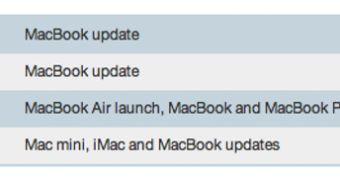Looking at Apple’s yearly schedules for product refreshes, one would be inclined to believe that the October-November 2010 timeframe holds at least one surprise from Cupertino - a revamped MacBook Air, a source claims.
A post at t-gaap.com (Three Guys And A Podcast) appropriately notes that “October is a very special month on the calendar for Apple, as it's the first month of their new fiscal year.”
The blog believes that Apple typically releases updates to its product line in the October/November timeframe to start the year off with strong sales.
It posts a schedule for Apple’s MacBook refreshes (screenshot available above) which indicates that this prognosis may, indeed, be accurate.
With the MacBook Air just begging for a refresh (the laptop hasn’t seen an upgrade in over a year), one can’t help speculate that Fall 2010 will witness the introduction of a new ultra-thin MacBook.
While the Mac maker is likely to retain the same design, under-the-hood refreshes are imminent, Softpedia also believes.
But why stop at the MacBook Air?
Surely Apple hasn’t kept the 13-inch polycarbonate MacBook alive for nothing, yet this laptop also lags behind in terms of processor speed and graphics, compared to the company’s latest portable offerings.
Provided that the 13-inch MacBook is still Apple’s most popular Mac, the company may well want to beef up this system again, bringing it up to par with the rest of the pack.
Better yet, Cupertino could up the ante for the 13-inch (aluminum) MacBook Pro, while dropping its price to $999 (currently the price for the plastic non-Pro model).
This would implicitly phase out the plastic model which, at the moment, is sort of the fifth wheel of the MacBook family.
Currently, the most affordable MacBook Pro ships with a 2.4GHz or 2.66GHz Intel Core 2 Duo processor, 4GB of memory, a 250GB hard drive and NVIDIA GeForce 320M graphics.
Apple may upgrade both the Air and the 13-inch pro with ATI graphics, higher clocked CPUs, and solid-state (SSD) storage as standard.

 14 DAY TRIAL //
14 DAY TRIAL //